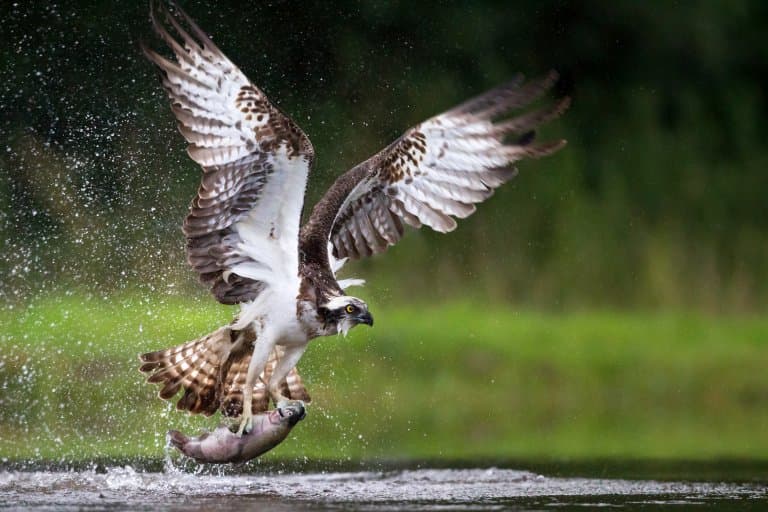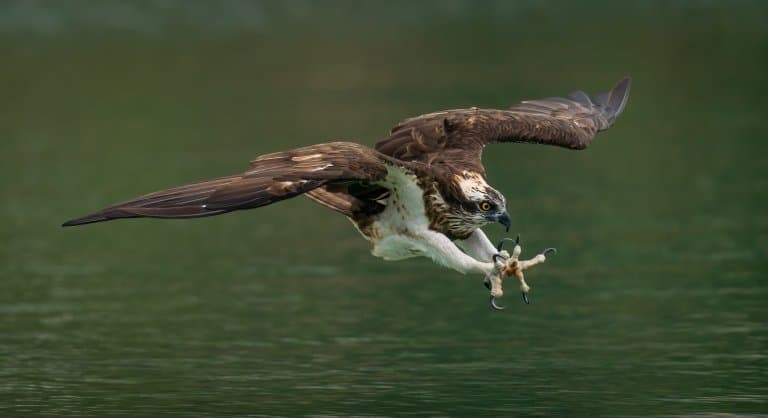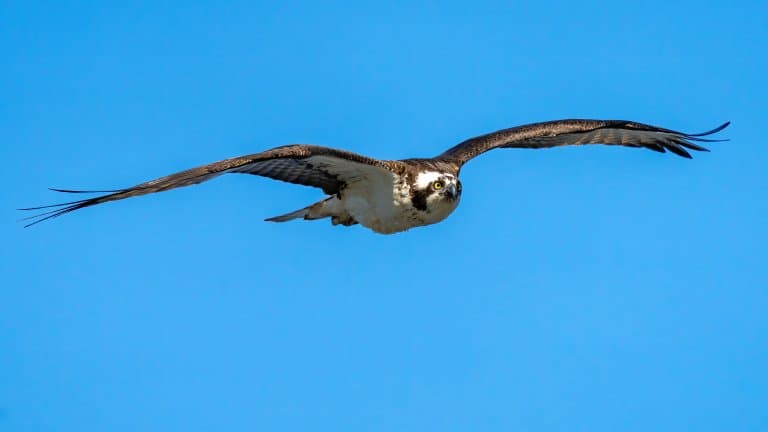Osprey Profile
Some animals are so glorious they inspire marketing companies for all sorts of products.
From backpacks to helicopters and even sports teams, the osprey has been honoured with a reputation for being resilient, powerful and rugged.
This large, fish-eating bird of prey can be found across every continent, except Antarctica – and is also referred to as the sea hawk, fish hawk, and river hawk.

Osprey Facts Overview
| Habitat: | Wooded areas, near water bodies |
| Location: | Worldwide |
| Lifespan: | Up to 32 years |
| Size: | 60 cm (24 inches) tall, 180 cm (71 inch) Wingspan |
| Weight: | Up to 2 kg (4.6 lb) |
| Color: | Brown, with a white or grey belly |
| Diet: | Fish |
| Predators: | Egg-eaters, owls |
| Top Speed: | 50 kmph (31 mph) |
| No. of Species: |
1 |
| Conservation Status: |
Least Concern |
Ospreys really do live up to the hype. They’re huge, powerful, specialized predators that just don’t quit. Despite being persecuted directly and suffering the consequences of an increasingly crowded and polluted world, these birds persist.
There’s only a single species of osprey which is unusual for a globally distributed bord. There are 3 recognised subspecies (some argue there are 4), with minimal differences.
They are able to tolerate a wide variety of habitats across the world, and will nest in locations near bodies of water, near its main food source.
The osprey is piscivorous, with fish making up 99% of its diet. It has unique adapatations and behaviour, that allow it to hunt its water-based prey.
Their global populations are bouncing back and they’re showing conservationists that they just need a little protection to make a remarkable recovery.
Interesting Osprey Facts
1. They have a remarkable range
The osprey occupies locations on every continent except Antarctica and is second only to the peregrine falcon in terms of distribution.
This single species is migratory, and populations move from Alaska to Florida, from Britain to Spain and North Africa.
This is both a blessing and a curse, as conservation statuses which focus on global populations regard it as ‘Least Concern’. Its populations are increasing globally, but in many locations, populations aren’t so healthy.
In the UK, they’re listed on the Amber list of “birds of conservation concern” because of long-lasting persecution. 1
2. They’re pike-eaters
Osprey are accomplished fish hunters and while most of their diet comprises smaller fish, they’re able to tackle far larger animals, too.
These big, powerful birds can even be seen snagging pike, and almost submerging themselves in the process. They approach from behind the fish, tucking their wings into a stoop just moments before crashing down on its back.
Ospreys do sometimes go for small mammals, birds and reptiles, but the vast majority of their diet comes from lakes and rivers.
3. They have unique adaptations for catching fish
Only the osprey and owl have special oppossable outer toes, allowing them to grasp slippery fish with two toes in front and two behind.
They have sharp spicules on the underside of their toes and barbed scales on their rounded rather-than-grooved talons, that help keep their catch secure.
Ospreys also have closable nostrils to keep out water out when they dive, and oily feathers to prevent them from being waterlogged.

4. They can see underwater
They’re so well adapted to hunting in water that they have a transparent membrane they can pull over their eyes so they can see underwater.
They’re also capable of compensating for the refraction of the water, making sure their strikes are always on target.
5. Ospreys are one of the fastest birds in the world
An osprey was recorded flying at speeds of 129 kph (80 mph) in 1943 and was reported in the Quarterly Journal of Ornithology.
Maurice Braun and Ben V. Goodwin reported a case of an osprey ‘cheating’; making use of a powerful thermal to hit a maximum flat speed of 80 mph.
This manipulation of an updraft allowed the bird to enter what would otherwise be a dive while maintaining altitude. The bird was mostly gliding but did contribute “two half-flaps”, so whether this counts or not is up to you.
6. They’re good breeders
Nesting by bodies of water, females will typically lay 3-4 eggs. This is more than fish eagles, who will be in competition with the ospreys for food in some regions and may even chase them down and steal their catch.
Females shelter and feed the young, and males do most of the hunting during this time. Ospreys make good parents, and their widespread distribution, long-distance flight capacity and sheer fecundity make them a very successful species, despite widespread persecution. 2

7. They’re rare in the EU
Despite their resilience, long-lasting battles with hunters, egg collectors and habitat destruction have reduced their populations significantly in Europe over the last century.
There are currently around 5,000 pairs across the EU, compared with 16,000 – 31,000 pairs of peregrines.
They’re also often killed by power lines and vehicle collisions as a result of living in proximity to human populations. However, the most damaging impact on their numbers comes from the pollution of their habitats.
As predators, they take on all the toxins absorbed by the animals they eat, and this amounts to a significant build-up of mercury in their diets which ultimately leads to lethal levels of toxicity in the birds. 3
8. They were wiped out in the UK
During the 19th and 20th centuries, the osprey populations in Britain were devastated by Victorian egg and skin collectors. Many were also shot for taxidermy collections.
By 1840, it was Extinct in England, and no more than a handful remained in Scotland, if any, after 1916.
However, a random stroke of luck allowed conservationists to jump at a second chance to protect this species on the British Isles.

9. Scandinavian populations repopulated the Scottish Highlands
In 1954, Scandinavian Scotland was revived when Nordic populations of osprey set up a home in the highlands. From 1959 to 2019, a nesting pair showed up at Loch Garten Osprey Centre, presumably after reading the sign.
The location became one of the most well-known and visited conservation sites in the UK. Repopulation was slow to get off the ground due to the persistence of egg collectors and poisonous pesticides, but by 1976, there were 14 recorded breeding pairs present.
Because ospreys are a single species, and they’re so cosmopolitan, the genetic distribution of the arriving populations will be close enough to the original populations.
By 2023, this number had gone up to more than 240 breeding pairs across Britain, mostly in Scotland.
This remarkable success represents a beautiful conservation collaboration between the RSPB, the Scottish Natural Heritage, Anglian Water, and the Leicestershire and Rutland Wildlife Trust.
But there are some unsung heroes in this story, too. 4

10. They inspired a conservation video game
Back in the ‘80s, kids were able to play the role of a conservationist and leader of an RSPB project called ‘Save the Ospreys’. By assigning wardens to protect osprey nests and eggs in a Commodore 64 game called Osprey! The plight of this local bird was brought to the public’s attention.
For some, this was the first time to hear of the animal at all and played a significant role in inspiring a new generation of conservationists as well as bringing the situation to light.
The game came with a detailed manual about the return of breeding pairs of Osprey to Scotland and a benchmark for success in the game based on real conservation numbers in the area.
Video games provide a unique medium for drawing attention to situations, and while Osprey! Was by no means a massive hit, some people are pushing for more efforts to incorporate conservation themes into video games in general. 5
Osprey Fact-File Summary
Scientific Classification
| Kingdom: | Animalia |
| Phylum: | Chordata |
| Class: | Aves |
| Order: | Accipitriformes |
| Family: | Pandionidae |
| Genus: | Pandion |
| Species Name: |
Pandion Haliaetus |
Fact Sources & References
- “What is the Red List for UK birds?“, RSPB.
- “Guide to North American Birds – Osprey“, Audubon.
- “Osprey“, European Commission.
- Graeme Green (2022), “Ospreys make triumphant return as breeding pairs spread across UK“, The Guardian.
- Theresa Machemer (2020), “Can video games make people care abut wildlife conservation?“, National Geographic.
